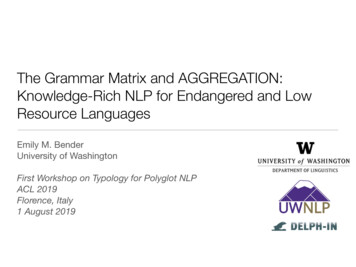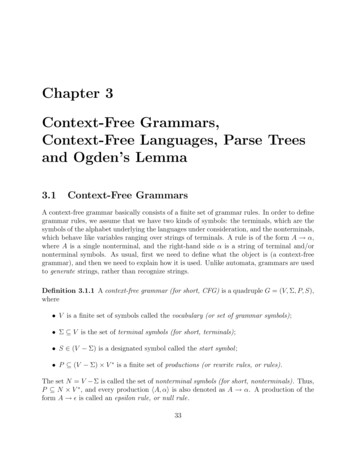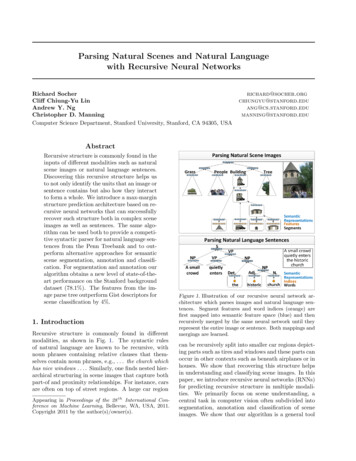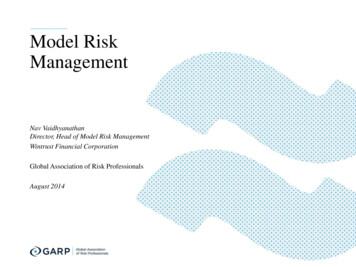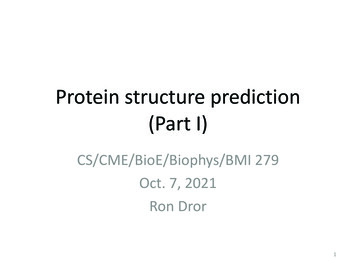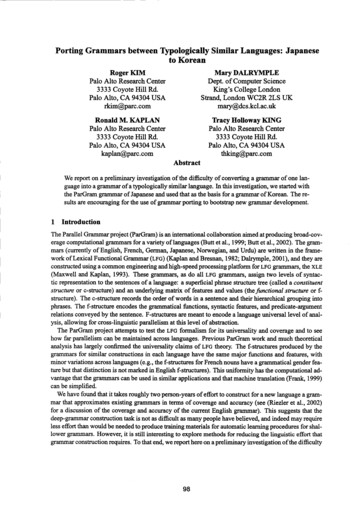
Transcription
Porting Grammars between Typologically Similar Languages: Japaneseto KoreanRoger KIMPalo Alto Research Center3333 Coyote Hill Rd.Palo Alto, CA 94304 USArkim@parc.comMary DALRYMPLEDept. of Computer ScienceKing's College LondonStrand, London WC2R 2LS UKmary@dcs.kaac.ukRonald M. KAPLANPalo Alto Research Center3333 Coyote Hill Rd.Palo Alto, CA 94304 USAkaplan@parc.comTracy Holloway KINGPalo Alto Research Center3333 Coyote Hill Rd.Palo Alto, CA 94304 USAthking@parc.comAbstractWe report on a preliminary investigation of the difficulty of converting a grammar of one language into a grammar of a typologically similar language. In this investigation, we started withthe ParGram grammar of Japanese and used that as the basis for a grammar of Korean. The results are encouraging for the use of grammar porting to bootstrap new grammar development.1 IntroductionThe Parallel Grammar project (ParGram) is an international collaboration aimed at producing broad-coverage computational grammars for a variety of languages (Butt et al., 1999; Butt et al., 2002). The grammars (currently of English, French, German, Japanese, Norwegian, and Urdu) are written in the framework of Lexical Functional Grammar (LFG) (Kaplan and Bresnan, 1982; Dalrymple, 2001), and they areconstructed using a common engineering and high-speed processing platform for LFG grammars, the XLE(Maxwell and Kaplan, 1993). These grammars, as do all LFG grammars, assign two levels of syntactic representation to the sentences of a language: a superficial phrase structure tree (called a constituentstructure or c-structure) and an underlying matrix of features and values (the functional structure or fstructure). The c-structure records the order of words in a sentence and their hierarchical grouping intophrases. The f-structure encodes the grammatical functions, syntactic features, and predicate-argumentrelations conveyed by the sentence. F-structures are meant to encode a language universal level of analysis, allowing for cross-linguistic parallelism at this level of abstraction.The ParGram project attempts to test the LFG formalism for its universality and coverage and to seehow far parallelism can be maintained across languages. Previous ParGram work and much theoreticalanalysis has largely confirmed the universality claims of LFG theory. The f-structures produced by thegrammars for similar constructions in each language have the same major functions and features, withminor variations across languages (e.g., the f-structures for French nouns have a grammatical gender feature but that distinction is not marked in English f-structures). This uniformity has the computational advantage that the grammars can be used in similar applications and that machine translation (Frank, 1999)can be simplified.We have found that it takes roughly two person-years of effort to construct for a new language a grammar that approximates existing grammars in terms of coverage and accuracy (see (Riezler et al., 2002)for a discussion of the coverage and accuracy of the current English grammar). This suggests that thedeep-grammar construction task is not as difficult as many people have believed, and indeed may requireless effort than would be needed to produce training materials for automatic learning procedures for shallower grammars. However, it is still interesting to explore methods for reducing the linguistic effort thatgrammar construction requires. To that end, we report here on a preliminary investigation of the difficulty98
of converting a grammar of one language into a grammar of a typologically similar language. In this investigation, we started with the ParGram grammar of Japanese (Masuichi and Ohkuma, 2003) and usedthat as the basis for a grammar of Korean.Typologically similar but not necessarily genetically related languages are those that not only admit ofsimilar f-structures, as LFG theory suggests is the case with all languages, but also have similar c-structureto f-structure mappings. Whether or not Japanese and Korean are genetically related (an issue that is insome dispute; see (Sohn, 1999) for some discussion), Japanese and Korean are typologically similar inat least the following ways: they both are verb final and more generally head final, have relatively freeword order, use postpositions to mark grammatical functions, and exhibit rampant pro-drop.2 Grammar Porting: Direct PortWe found that many rules of the Japanese grammar could be used without modification in the Koreangrammar. This was particularly the case for the majority of annotated phrase structure rules that producethe LFG c- and f-structures for the basic constructions of languages. In this section, we discuss the areasin which direct porting was possible.2.1 The Japanese ParGram GrammarThe creation of the current Japanese grammar involved two person years of work at Fuji Xerox (see (Masuichi and Ohkuma, 2003) for details on the design of the grammar system and on its coverage). Thegrammar has broad coverage, providing parses for 97% of sentences in a large test suite with good accuracy. Ambiguity is kept to a minimum due to the integration of the ChaSen tokenizer as a preprocessor. Inaddition to string segmentation, the ChaSen tokenizer helps to disambiguate part of speech in the input.To give an idea of its size, the Japanese grammar has 54 rules which compile into finite-state machineswith a total of 360 states, 1247 arcs, and 1830 disjuncts.2.2 Grammar RulesOne set of rules that could be ported directly from the Japanese grammar to the Korean one were thosecharacterizing clausal word-order possibilities. These rules encode basic verb final order with free ordering of preceding arguments and adjuncts but also include some markings for prefered word orders (e.g.,subject preceding object). Sample orders covered by the grammars are shown in (1) and (2).(1) a. Ayuko ga gakusei ni hon wo ageta.Ayuko NOM student DAT book ACC gave Ayuko gave the student a book.' (Japanese)b. gakusei ni hon wo Ayuko ga ageta.c. hon wo Ayuko ga gakusei ni ageta.(2) a. Myungwoni ga haksaeng ehgeh chaek ul juuttda.Myungwoni NOM student DAT book ACC gave Myungwoni gave the student a book.' (Korean)b. haksaeng ehgeh chaek ul Myungwoni ga juuttda.c. chaek ul Myungwoni ga haksaeng ehgeh juuttda.The structures for the Korean sentence in (2a) is shown in Figure 1. The corresponding Japanese structurefor (la) is shown in Figure 2.Similarly, the rules for topicalization could also be ported without modification. In Japanese, nounphrases are marked as topicalized by the postposition ha. Topicalized noun phrases may have certainpostpositions before the final ha, as in (3a). However, nominals with postposition case markers such as99
ROOTCS 1:Salrj PERIODS."Minjaga haksaengehgeh chaekul juuttda."NPPREDNPoblPPsubjNadjSUBJI 7\I NomNMin j agaIINzero Dir2 NadjPPobjOBJIVverbNzero PPobj BASE V AUXpast BASEN Acc juuttda PastNhaksaengehgeh'ehgeh [7:haksaeng rRED 'haksaengl7t: ERS 3OBL(POST-TYPE ni - heCHECK8 POST-FORM eh'chaek'OBJ15 ASE acc, PERS ATNS-ASP MOOD indicative, TENSE past]23 PASSIVE -, STMT-TYPE decl, VTYPE mainPREDNPNzero PPsubj BASE Nadj PPobl BASE'juda [0:Minja], [15:chaelc], [8 :ehgeh] '[PRED 'Minja'0 CASE nom, PERS 3, PROPER namlchaekulFi gure 1: Korean c-structure and f-structure for (2a)Cs 1:ROOTif\Sad] PERIOD!w.11112 RED9 *if 6 [0:M*] , [20:*], [12ziC] 'PRED5UPt *116 Pt,m ,RAIlT properSUBJUadj PPsubj uPoblIUtters1 //\\Uadj PPoblImrPROPER.10ERS 3Oadj PPobj VverbIr'SEM FTAME — TYPE given,0 AlITH 1 CASE zom, PERS 3RED 'IZ: [10:it],vRED le I 111PMem1I TYPEHECK rry TYPE mi-tui12 ORM L:ir\V AUKpastI*tit.I;0Ba4.MD s '20 ASE acc, PERS 311 'US -ASP itOOD indicative, TE11SE past]2713AS SIVE -, STMT-TYPE de cif VTYPE mainFigure 2: Japanese c-structure and f-structure for (la)or no cannot be topicalized by ha. Instead, the postposition is dropped and only ha appears, asin (3c). In addition, these phrases are marked in the f-structure as to their topic status; this f-structureinformation controls their syntactic distribution in the sentence. The corresponding topicalizing postposition in Korean is un/nun, with the allomorph un following consonant-final nominals and nun followingvowel-final nominals, as in (3b). Just as with the Japanese ha, the Korean topicalizer also cannot cooccurwith postpositions marking the basic grammatical functions, as in (3d).wo, ga,(3) a. kinoomade hayesterday until TOPIC until yesterday (topic)' (Japanese)c. *kinoo ga hakinoo hab. uhjehkaji nunyesterday until TOPIC until yesterday (topic)' (Korean)d. *uhjeh ga nunuhjeh nunNominal internal structure was also ported directly from the Japanese grammar to the Korean. Thisincludes the analysis of adjectival, nominal, and postpositional modifiers of the head noun. For example,the rules used to produce the analysis for the Japanese complex nominal in (4a) were ported directly toproduce the analysis of the Korean nominal in (4b).100
(4) a. Ayuko-noookii ekun kurim chaekhon b. Myungwoniuipicture bookMyungwoni-GEN big picture bookAyuko-GEN big Myungwoni's big picture book' (Korean) Ayuko's big picture book' (Japanese)Similarly, the rules building oblique noun phrases, i.e., noun phrases with postpositions that serve asoblique arguments of verbs, were ported directly. An example in Japanese is shown in (5a) with the corresponding Korean phrase in (5b).ni(5) a. ooki iebig house at in the big house' (Japanese)ehb. kun jibbig house at'in the big house' (Korean)A rule fragment for these oblique noun phrases from the Japanese grammar is shown in (6).Nadj : (- OBJ) !PPobl: - !IAN: (- OBJ) !PPobl: - !(! CHECK POST-TYPE) c 'to-ni'--)In the first disjunct in Rule (6) (from { to I), the NPobl consists of an Nadj which is the OBJ of the corresponding f-structure (Nadj: ("OBJ) ! ) followed by a PPobl postposition which is the head of the corresponding f-structure (PPobl: ! ). 1 The second disjunct (from I to I) is similar except that the PPoblis restricted to postpositions of the type to-ni and the OBJ of this postposition is an AN instead of theusual Nadj. Note that the to-ni value is particular to Japanese; however, the corresponding Korean formcan be provided with this value to satisfy the constraints? Other disjuncts are found in this rule, indicatedhere byl. . .1.We were also able to port the implementation of pro-drop for subjects and objects. Examples of sentences with a pro-dropped subjects for Japanese and Korean are seen in (7). The analysis correspondingto the Korean sentence is shown in Figure 3.(6) NPobl --- (7) a. jitensha de ie ni kaeru.bicycle by home to return(I/You/He/She/We/They) return home by bicycle.' (Japanese)b. jajungu ro jib eh dorakanda.bicycle by home to return (I/You/He/She/We/They) return home by bicycle.' (Korean)Pro-drop is analyzed by optionally providing a null pronominal subject and/or object for each verb framethat subcategorizes for these functions. If an overt subject or object is found in the clause, then the prodrop option is not chosen because the PRED of the overt subject would fail to unify with the PRED ofthe optional pronominal subject. However, if there is no overt subject, then the pro-drop option mustbe chosen because otherwise the subcategorization requirements of the verb would not be met. The nullanaphor template NA that provides the pronominal arguments is shown in (8a), where GF is a grammaticalfunction value that is passed in by the verbal template. (8b) shows the expansion of the template for prodropped subjects.1 In the XLE grammar development platform, the corresponds to the traditional LFG t and the ! corresponds to the traditionalLFG2 In a number of places in the grammar, surface form features are checked; the values of these features must be changed fromJapanese to their Korean equivalents. However, once this translational port is made, the rules can be used directly.101
CS 1:ROOTSadj PERIOD"jajunguro jibeh oblj aj unguroNzeroI VN, Dir3 V AUXpres BASEN1dorakanda Presj ibehOBJ'eh (8:jibl '[PRED 'jib'8 LOCATION-TYPE general, PERS[POST-TYPE ni]CHECK9 POST-FORM ehNzero PPadjunct BASE Nadj PPoblBASE Vverb Facdorakada (15-SUBJ : pro] , 9 : eh] ''pro'PRON-TYPE null[PEEDPRED 'ro ( 0 : jajungu) '[PRED 'jajungul0 PERS 3ADJUNCTCHECK [POST-TYPE de]1 ADJUNCT-TYPE postpositional, POST-FORM ro.OBJTNS-ASP (MOOD indicative, TENSE press15 PASSIVE -, STMT-TYPE decl, VTYPE mainFigure 3: Pro-drop: Korean c-structure and f-structure for (7b)(8) a. NA(GF) @(DEFAULT GF PRED) C GF PRON-TYPE) 'pro' null).b. C Sum PRED) 'pro' SUBJ PRON-TYPE) nullThe ability to drop postpositional case and discourse function markers was also ported directly. Ina standard SOV (or OSV) sentence, if the accusative case marker is dropped, but the nominative casemarker is not, as in (9b), the sentence is given only one parse with the case-less noun phrase taking theobject function and the nominative case-marked noun phrase being the subject of the sentence. The sameholds when only the nominative case marker is dropped but the accusative is not, as in (9c). When bothcase markings are dropped, as in (9d), the sentence is given two parses with each noun phrase being thesubject in one parse and the object in the other. The Japanese equivalents of (9) receive the same analyses.(9) a. MinjagaTaesunul boattda.Minja-NOM Taesun-ACC saw Minja saw Taesun.' (Korean)b. Minjaga Taesun boattda.c. Minja Taesunul boattda.d. Minja Taesun boattda. Minja saw Taesun.' (preferred due to default word order)Thus, due to the similarity of the c-structure between Japanese and Korean and to the similarity of themapping from c-structure to f-structure, annotated phrase structure rules already existing in the Japanesegrammar could be ported without change to a Korean grammar, as illustrated here by Rule (6) and Template (8).3 Grammar Porting: Necessary ChangesThe previous section described ways in which Japanese grammar rules could be used directly in the Korean grammar. This was true for many core constructions, thus eliminating the need to construct such corerules for the Korean grammar. However, there are several aspects of the Japanese grammar that could notbe ported directly. In this section we discuss three places where this was the case: the tokenizer and morphology, the lexicon, and some of the rules.102
3.1 The Tokenizer and MorphologyTokenization and morphological analysis could not be carried over from Japanese to Korean. The Japanesegrammar uses the independently developed ChaSen module for a single processing stage that divides thetext into tokens and at the same time provides certain part-of-speech information. The output of this stagebecomes the immediate input to the syntactic analysis component, bypassing the tokenizing and morphology transductions that perform these functions for the other ParGram languages. 3 However, Korean typographical conventions, both in the Romanization we used in this experiment and also in normal Hangulscript, are typologically much more similar to those of the other ParGram languages in the way that spacesand punctuation are used to delimit words. We were thus able to port the English finite-state tokenizingtransducer to Korean with only a few minor modifications: we removed the provisions in the Englishtransducer for lower-casing capitalized words and we eliminated the special treatment of periods as abbreviation indicators.We were also able to use standard finite-state technology (see (Beesley and Karttunen, 2003) and references therein) to construct a simple morphological analyzer for Korean. 4 The morphology transducerreceives the word-tokens produced by the tokenizing transduction and decomposes the Korean nouns andverbs it identifies into stems and affixes. For example, chaekul is analyzed by the morphology as chaek Noun Acc. The stems and affixes are then referred to the Korean lexicon to obtain their f-structuremeaning and inflectional properties.3.2 The LexiconUnlike the majority of annotated c-structure rules, the lexical items differ significantly between Japaneseand Korean, and the lexicon needed substantial modification in the grammar porting. However, once thelexical item head-words were changed, the information in many entries remained the same. For example,the entry for the Japanese accusative postposition wo is identical to that of the Korean accusative postposition ul/rul other than the fact that the Korean postposition is mapped onto a Acc morphological tag,e.g., both assign accusative case in the same environments. Thus, the Japanese entry for wo was portedto the Korean entry for Acc. This was similar for the majority of closed class items.At this point we are working with a toy lexicon for open class items, although all the closed class itemshave been translated. We anticipate no problem for open class items with predictable subcategorizationframes such as nouns, adjectives, and adverbs. In fact, no direct translation porting of these items is necessary because given a large morphological analyzer for Korean, these forms will not need explicit lexicalentries. Instead, lexical entries will be created "on the fly" based on the morphological tags. For example, there would be no overt lexical entry for the name Minja. Instead, the morphology would produce thestem and tags of the form Minja Noun Proper. Based on these tags, the noun would receive the correctpart of speech and f-structure information for a proper noun. This is the system currently employed in theother ParGram grammars for items with predictable (or no) subcategorization frames. It is implementedin the Korean grammar for the small morphology that is currently being used and will need little modification to scale to a broad coverage morphology. Unfortunately, this system cannot be used for itemswith unpredictable subcategorization frames, such as verbs. We plan to attempt a port for these items,but we anticipate that there will be mismatches in the Japanese and Korean equivalents of certain verbsdue to translational mismatches, and so other methods of creating a lexicon for these Korean verbs willbe needed.Thus, by using a Japanese-Korean dictionary to translate the head words in the lexicon and a largefinite-state morphology, a detailed lexicon can be semi-automatically created for Korean.3The Japanese grammar could in principle also use a cascade of transducers similar to the other ParGram grammars. However, the availability and high accuracy of the ChaSen tokenizer and part-of-speech tagger made it appealing for the Japanesegrammar to use a different system design. See (Masuichi and Ohkuma, 2003) for details of the system architecture.4As this project scales up, we will most likely exchange our simple transducer for a larger, commercially available transducerbased on the same technology and also compatible with the XLE system.103
3.3 Sublexical and Phrase Structure RulesIn addition to these lexicon and tokenization and morphology preprocessing steps, some minor changesto the core annotated phrase structure rules were needed. Most of these occurred in the domain of suffix.syntax. That is, they are a result of morphosyntactic differences between Japanese and Korean that require modification to the c-structure rules. For example, the Japanese grammar allows both orders for thelocation suffix in conjunction with the topic suffix. However, in Korean, only the order location-suffixfollowed by topic-suffix is possible (e.g., eh nun); thus, the rule had to be further constrained for the Korean grammar. There were a number of places in the grammar where this type of minor, but significant,change was made in the ordering restrictions on inflectional morphemes (be they affixes or independentwords).In the clausal domain, a significant effort will be necessary for expanding (or collapsing) the Japaneserules according to the verbal morphology of Korean. The current Japanese grammar requires a certain,amount of morphological preprocessing for the input string to parse. This is done via the ChaSen tokenizer. For instance, taberuyoonisuru 'make effort to eat' must be tokenized as taberu yoo ni suru beforeit is presented to the parser. In this case, suru maps one-to-one to the Do tag which the Korean morphology analyzer produces, allowing the grammar writer to port the lexical entry for suru to the (sub)lexicalentry for Do. However, a one-to-one correspondence is not always guaranteed, and rule changes areinevitable. Artificially creating dummy tags or collapsing tags in the morphological analyzer to ensure aone-to-one correspondence is undesirable as it would not accurately reflect the morphological informationembedded in the inflected Korean verb. Consider the Japanese and Korean pair in (10) for the equivalentof the English make effort to eat.(10) a. Japanese: surface form:taberuyoonisurumorphology breakdown: taberu yoo ni summeaning:make effort to eatb. Korean:surface form:mukuryo hadamorphology breakdown: mukda Verb Effort Domeaning:make effort to eatThe difference in the structure of the languages for this construction results in a need for different cstructure trees. These are seen in (11) (the dashed lines indicate that some intervening nodes are not included; these nodes are relevant for preverbal argument attachment and not for the verbal complex itself).(1I) a.b.SADJ- VVERBVVERBVBASE VSFX VACT VLIGHTmukda Verb Effort DoVtaberuAUXN EPSUCyoonisumThe phrase structure rules so far have only required modification for the differences in how certain morphological endings are encoded. So, the majority of the changes have affected sublexical rules, althoughmore major changes to the verbal complex were also required. We suspect that as the grammar port movesbeyond core syntactic structures to more "peripheral" ones, there will be further changes to the annotatedphrase structure rules that involve more than morphosyntactic differences. In particular, Korean allowsadverbial sentential negation as well as the suffixal negation found in Japanese and allows certain doubleaccusative constructions which are impossible in Japanese. We hope to be able to report on these in thenear future.4 ConclusionWe are encouraged by our success in this preliminary investigation. With only two man-months of effort,we found that major parts of the Japanese LFG grammar could be carried over unchanged into a grammar104
of Korean. Many of the core annotated phrase structure rules remain the same, and it seems that manylexical items can be ported merely by changing the head-word of the entry to its Korean equivalent. Newfinite-state machines for tokenization and morphological analysis had to be created and incorporated intothe system, as was to be expected. Of course, much work needs to be done to bring Korean coverage up tothe level of the Japanese grammar. Apart from a substantial amount of testing that needs to be done, thiswork will focus on peripheral syntactic rules and expansions to both the lexicon and morphology. Butmore generally, we conclude from this limited experiment that porting grammars across typologicallysimilar languages is an effective method for bootstrapping grammar development.AcknowledgementsThe Japanese grammar was written by Hiroshi Masuichi and Tomoko Ohkuma of the Fuji Xerox Corporation. We gratefully acknowledge their allowing us to use their grammar in our investigation and theirassistance in helping us to understand its properties. We also thank them for commenting on earlier draftsof this paper.ReferencesBeesley, Kenneth and Lauri Karttunen. 2003. Finite-State Morphology: Xerox Tools and Techniques. CSLI Publications, Stanford, California.Butt, Miriam, Helge Dyvik, Tracy Holloway King, Hiroshi Masuichi, and Christian Rohrer. 2002. The ParallelGrammar project. In COLING 2002: Workshop on Grammar Engineering and Evaluation, pages 1-7.Butt, Miriam, Tracy Holloway King, Maria-Eugenia Nino, and Frederique Segond. 1999. A Grammar Writer'sCookbook. CSLI Publications, Stanford, California.Dalrymple, Mary. 2001. Lexical-Functional Grammar. Academic Press, New York. Syntax and Semantics,volume 34.Frank, Anette. 1999. From parallel grammar development towards machine translation. In Proceedings of MTSummit VII, pages 134-142.Kaplan, Ronald M. and Joan Bresnan. 1982. Lexical-Functional Grammar: A formal system for grammaticalrepresentation. In Joan Bresnan, editor, The Mental Representation of Grammatical Relations. The MIT Press,Cambridge, Massachusetts, pages 173-281.Masuichi, Hiroshi and Tomoko Ohkuma. 2003. Constructing a practical Japanese parser based on LexicalFunctional Grammar. Journal of Natural Language Processing, 10(2). To appear; in Japanese.Maxwell, III, John T. and Ronald M. Kaplan. 1993. The interface between phrasal and functional constraints.Computational Linguistics, 19:571-589.Riezler, Stefan, Tracy Holloway King, Ronald M. Kaplan, Richard Crouch, John T. Maxwell III, and Mark Johnson. 2002. Parsing the Wall Street Journal using a Lexical-Functional Grammar and discriminative estimationtechniques. In Proceedings of the ACL.Sohn, Ho-min. 1999. The Korean Language. Cambrige University Press, Cambridge. Chapter 2.4.105
Ayuko's big picture book' (Japanese) Myungwoni's big picture book' (Korean) Similarly, the rules building oblique noun phrases, i.e., noun phrases with postpositions that serve as oblique arguments of verbs, were ported directly. An example in Japanese is shown in (5a) with the cor-responding Korean
